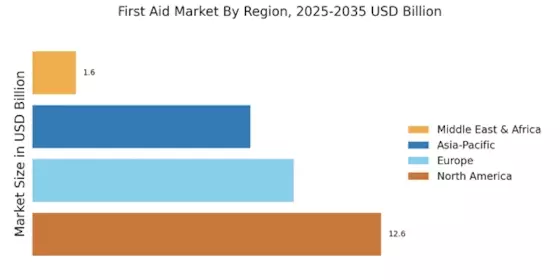Expansion of E-commerce Platforms
The First Aid Market is witnessing a transformation due to the expansion of e-commerce platforms. The convenience of online shopping has made it easier for consumers to access a wide range of first aid products. This trend is particularly significant as it allows for greater product visibility and accessibility, catering to diverse consumer needs. Market data suggests that online sales of first aid supplies have increased substantially, driven by the growing preference for digital purchasing. As e-commerce continues to evolve, the First Aid Market is expected to adapt by enhancing online offerings and improving customer engagement through digital marketing strategies. This shift not only broadens the market reach but also fosters competition among suppliers.
Rising Incidence of Accidents and Injuries
The First Aid Market is experiencing growth due to the increasing incidence of accidents and injuries across various sectors. According to data, road traffic accidents, workplace injuries, and sports-related injuries contribute significantly to the demand for first aid products. As the number of injuries rises, the need for effective first aid solutions becomes paramount. This trend is particularly evident in regions with high industrial activity and sports participation. The First Aid Market is thus likely to see a surge in demand for comprehensive first aid kits and training programs, as organizations and individuals seek to mitigate the impact of injuries. Furthermore, the emphasis on workplace safety regulations may drive companies to invest in first aid supplies, thereby enhancing the overall market landscape.
Growing Health Consciousness Among Consumers
There is a notable shift in consumer behavior towards health consciousness, which is positively influencing the First Aid Market. Individuals are increasingly prioritizing their health and well-being, leading to a heightened awareness of the importance of first aid preparedness. This trend is reflected in the rising sales of first aid kits and related products, as consumers seek to equip themselves with essential supplies for emergencies. Market data indicates that the demand for portable and user-friendly first aid solutions is on the rise, particularly among families and outdoor enthusiasts. As health awareness campaigns proliferate, the First Aid Market is likely to benefit from an expanding customer base that values preparedness and safety.
Increased Focus on Workplace Safety Regulations
The First Aid Market is significantly influenced by the increased focus on workplace safety regulations. Governments and regulatory bodies are implementing stringent safety standards that require organizations to maintain adequate first aid supplies and training. This regulatory environment compels businesses to invest in first aid kits and training programs, thereby driving market growth. Data indicates that sectors such as construction, manufacturing, and healthcare are particularly affected, as they face higher scrutiny regarding employee safety. Consequently, the First Aid Market is likely to see a rise in demand for specialized first aid solutions tailored to meet regulatory requirements, enhancing overall workplace safety.
Technological Advancements in First Aid Products
Technological advancements are playing a crucial role in shaping the First Aid Market. Innovations in product design and functionality are leading to the development of more effective and user-friendly first aid solutions. For instance, the introduction of smart first aid kits equipped with digital instructions and emergency response features is gaining traction. These advancements not only improve the efficacy of first aid responses but also enhance user confidence in managing emergencies. Market data suggests that consumers are increasingly drawn to technologically advanced products, which may drive the First Aid Market towards further innovation and diversification. As technology continues to evolve, the potential for new product offerings in the first aid sector appears promising.


















Leave a Comment